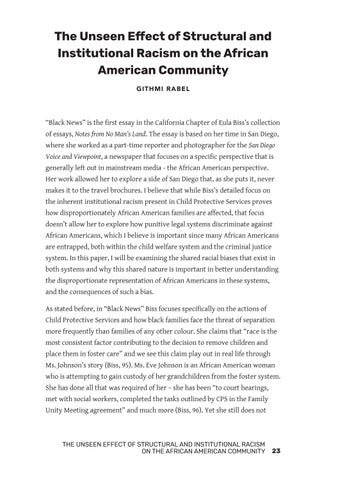The Unseen Effect of Structural and Institutional Racism on the African American Community G I TH M I R A B E L
“Black News” is the first essay in the California Chapter of Eula Biss’s collection of essays, Notes from No Man’s Land. The essay is based on her time in San Diego, where she worked as a part-time reporter and photographer for the San Diego Voice and Viewpoint, a newspaper that focuses on a specific perspective that is generally left out in mainstream media - the African American perspective. Her work allowed her to explore a side of San Diego that, as she puts it, never makes it to the travel brochures. I believe that while Biss’s detailed focus on the inherent institutional racism present in Child Protective Services proves how disproportionately African American families are affected, that focus doesn’t allow her to explore how punitive legal systems discriminate against African Americans, which I believe is important since many African Americans are entrapped, both within the child welfare system and the criminal justice system. In this paper, I will be examining the shared racial biases that exist in both systems and why this shared nature is important in better understanding the disproportionate representation of African Americans in these systems, and the consequences of such a bias. As stated before, in “Black News” Biss focuses specifically on the actions of Child Protective Services and how black families face the threat of separation more frequently than families of any other colour. She claims that “race is the most consistent factor contributing to the decision to remove children and place them in foster care” and we see this claim play out in real life through Ms. Johnson’s story (Biss, 95). Ms. Eve Johnson is an African American woman who is attempting to gain custody of her grandchildren from the foster system. She has done all that was required of her – she has been “to court hearings, met with social workers, completed the tasks outlined by CPS in the Family Unity Meeting agreement” and much more (Biss, 96). Yet she still does not
THE UNSEEN EFFECT OF STRUCTURAL AND INSTITUTIONAL RACISM ON THE AFRICAN AMERICAN COMMUNITY
23






